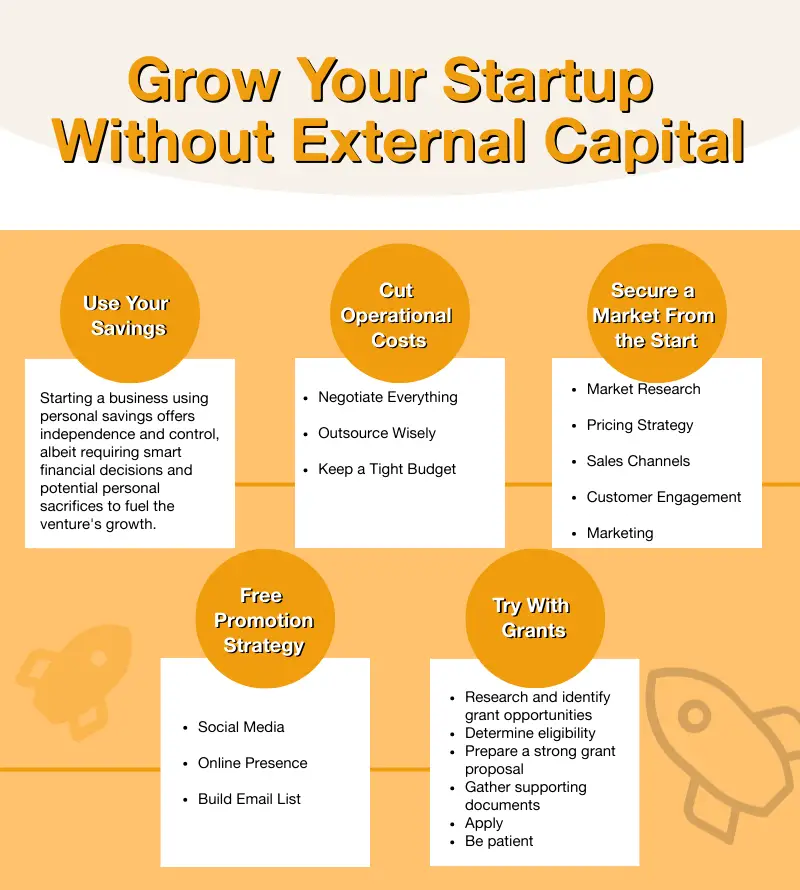When you think about starting your own business, you probably think about getting lots of money from investors, right?
But lots of successful business owners do it differently.
They count on the stuff and money they have, their good ideas, and making smart plans.
Doing it this way is called “bootstrapping.”
Now, let’s find out how to use it in the right way.

Table of Contents
ToggleUse Your Savings
When you are interested in starting a business, you may find yourself relying on your savings to get things off the ground.
I know that it can be difficult and limiting, but is still possible. All you need is a clear idea and a proper saving strategy.
By using your funds, you not only invest your money but also maintain full ownership and control over the venture.
The good side is also the lack of stress about meeting the expectations of investors or giving away a slice of your company in the early stages.
The level of independence allows you to shape your business according to your vision and values.
But let’s be real – it also means you’ve got to be smart with your financial decisions.
It might require making some sacrifices in your personal life to put every penny back into your startup.
Cut Operational Costs

Startups without outside funding, like seed funding, need to keep their expenses low. Here’s how they can effectively manage their costs:
- Use Free Software: Rely on free or open-source software for tasks like email, document creation, and project management.
Automate: Look for tools that automate tasks to save time. Find affordable options that suit your needs.
Negotiate Everything
- Suppliers and Services: Always negotiate for better prices or payment terms.
Equipment: Consider buying used or refurbished equipment to cut initial costs.
Outsource Wisely
- Focus on what you do best. Outsource tasks like accounting, marketing, and IT support.
- Use freelancers or agencies. They can be more cost-effective than hiring full-time staff.
Micah Logan from Forbes claims that Independent contractors can save a service-based business 20%-30%.
Keep a Tight Budget
- Track Every Penny: Keep tabs on your expenses using budgeting software.
Prioritize Spending: Allocate funds to activities that drive growth and cut back on non-essential items.
Secure a Market Right From the Start

It’s a necessity for survival and growth. Here are detailed strategies to help achieve this crucial goal:
Market Research
Know what your customers actually want. Use surveys, interviews, and a look at the market to understand their needs.
Pricing Strategy
- Look at Your Competitors: Make sure your pricing is in line with the market but also reflects the value of what you’re offering.
- Introductory Offers: Use discounts or special deals to attract your first customers and get them interested in your product.
Sales Channels
- Online Presence: Use your website and social media to talk about your product and connect with potential customers. Make sure people can find you through search engines and targeted advertising.
- Word-of-Mouth: Encourage people to recommend your product to others. Consider offering incentives for referrals.
Customer Engagement
- Keep in Touch: Regular updates and support can help build a loyal customer base. Make sure your customers feel valued.
- Listen to Feedback: Use customer feedback to make your product better. Showing that you listen can also make your customers feel appreciated.
Marketing
- Content Marketing: Share useful content that helps solve your customers’ problems. This can help you build trust and authority in your market.
- Email Marketing: Keep your customers updated with newsletters, product news, and special offers. Personalize your emails to make them more effective.
Extra Tips
- Network: Attend industry events to showcase your product and meet potential customers. There are some interesting events you can still catch up on by the end of April, you can check them up here.
- Customer Service: Good customer service can set you apart from the competition, especially in the early stages.
Implement Some Free Promotion Strategies

Starting a new business without money can be tough.
You gotta find ways to let people know about your company without spending a dime!
Well don’t worry, I’m gonna share some awesome free marketing ideas you can use right away.
Social Media
Spend time each day posting fun stuff on Facebook, Instagram, X, and whatever else your customers use.
But don’t just promote – interact and build a real community!
Also, ask happy customers to share their experiences. This brings in new people and gets your message out there naturally.
Increase Your Online Presence
Make sure websites are set up so search engines like Google can find them easily.
Use important keywords, descriptions, and photos.
Publish helpful blogs, guides, and infographics too – this will attract new visitors without spending a penny!
Build Your Email List
Offer a gift like an ebook in exchange for emails. Then send regular updates with tips, deals, and more to keep those people engaged. Customizing your messages increases the chances people will open them.
You Can Try With Grants

Competition for grants can be fierce, and not all startups will be successful in securing grant funding.
But you can try with these steps:
- Research and identify grant opportunities: Look for grants that are specifically designed for startups or small businesses. Government agencies, foundations, and organizations often offer grants for various industries and purposes. Websites like Grants.gov and NerdWallet can be helpful resources to find grant opportunities.
- Determine eligibility: Once you find potential grants, carefully review the eligibility criteria. Grants may have specific requirements such as the type of business, location, industry, or stage of development. Make sure your startup meets all the eligibility criteria before proceeding with the application process.
- Prepare a strong grant proposal: Grant applications typically require a detailed proposal outlining your business idea, goals, and how the grant funds will be used. Your proposal should demonstrate the potential impact of your startup and how it aligns with the grant’s objectives. Be sure to highlight the unique aspects of your business and why it deserves funding.
Example of a grant proposal
| Section | Description |
|---|---|
| Executive Summary | A concise overview of your proposal, highlighting the key points of your project, the problem it addresses, and the impact it aims to have. |
| Statement of Need | Describe the problem that your project will solve, backed by evidence and data to show why it’s important. |
| Project Description | Outlines the specifics of your project, including goals, objectives, methods, and the timeline for implementation. |
| Budget | A clear and detailed budget shows how the grant funds will be used and demonstrates financial responsibility and planning. |
- Gather supporting documents: Along with the grant proposal, you may need to provide additional documents such as financial statements, business plans, resumes, and references. Prepare these documents in advance to ensure a smooth application process.
- Apply: Follow the instructions provided by the grant provider and submit your application before the deadline. Pay attention to any specific formatting or submission requirements. It’s a good idea to double-check your application for completeness and accuracy before submitting it.
- Follow up and be patient: After submitting your application, it may take some time to hear back from the grant provider. Be patient and follow up if necessary. If your application is successful, you will receive the grant funds along with any reporting or accountability requirements.
I’ve found some successful stories, here is one example:
Chris Ronzio, the CEO and founder of Trainual, a company that offers online training manuals and standard operating procedures for businesses, secured a $150,000 grant from the Arizona Innovation Challenge (AIC).
The Bottom Line
So, you’ve made it to the end, and here’s the deal: bootstrapping isn’t easy. You’ll hustle, scrape, and maybe even doubt yourself.
But guess what? That’s okay. It’s all part of the game when you decide to fuel your dream on your own dime.
Cutting costs, hustling for that first sale, and getting creative with marketing are your tools. And grants? They’re like the bonus level in this game.
Related Posts:
- How Can Startup Consulting Help Your Business Grow?
- What Is Startup Capital - Types, Sources, and Tips
- What Is One Way to Begin Saving Startup Capital?…
- Startup's Guide to Venture Capital Funding - How To…
- How To Watch NBA Games Live Without Cable Using…
- Road Rally on ABCya: The Only Driving Game That Gets…










